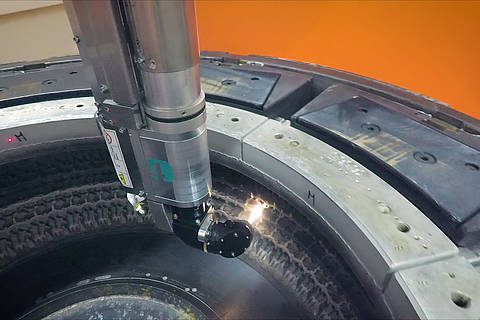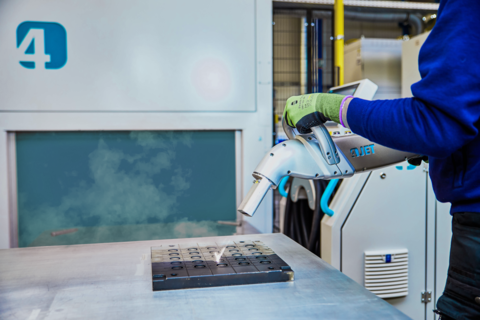Laser Tire Mold Cleaning
Tire molds require frequent cleaning to remove residues from molding by products and release agents. Only perfectly clean molds deliver spotless tires without blemishes and other defects.
What has long been a headache in tire manufacturing and a fairly complex – yet a "non core" process - is becoming an increasingly critical operation:
- Tire makers fight for every differentiator and appearance is one of them
- Progress in mold venting technology is driving new requirements to mold cleaning: fragile mechanical venting systems or puzzle molds may not be damaged
- New design features such as high contrast sidewall engravings with delicate feature sizes are vulnerable to pressure cleaning
- A growing number of tire types and SKU require a higher level of automation in mold cleaning
All these trends support the ongoing transition to laser cleaning in tire mold maintenance.
Tire Appearance – Making Quality Visible
Modern tires are high-tech products that are exposed to high stress in daily use, have a major influence on the driving performance of an automobile and are highly relevant to safety. Customers expect quality and their first evaluation criterion is the visual impression of the tyre.
A clean surface, an attractive design, easily legible sidewalls and smooth treads without flash from vent openings are important quality features for a tyre.
As a result, the demands on tire molds, which are ultimately responsible for the tire surface, are constantly increasing. Modern tire molds use spring vents and often have extremely fine structures in the sidewall improving the appearance with high contrast and thus best legibility
Contactless and non-abrasive cleaning
Such modern tire molds can no longer be cleaned with blasting processes that were previously in use. Sand and other blasting media clog the spring vents and the abrasive cleaning mechanism of such processes wears out the mold. Structured sidewall surfaces degenerate quickly and the contrast on the tire diminishes with each cleaning.
Laser cleaning enables the removal of the unwanted contamination without damaging the underlying metal surface of the mould. Due to significantly higher ablation threshold of the mold surface compared to the molding residue, the process efficiently cleans the surface without damaging it.
Minimal Emissions and reduced Carbon Footprint
The process works equally well on cold and hot molds, eliminating the need to heat the mold outside the press as for dry ice blasting. Even without this effect, energy consumption and carbon footprint are considerably lower than with dry ice cleaning. The latter already requires a high energy input during the production and storage of the blasting material (frozen CO2) and consumes large amounts of energy-intensive compressed air during cleaning.
Using laser cleaning the contamination removed from the mold is captured in a filter system and the disposal volume is limited to the actual debris. In blasting processes, on the other hand, the mold dirt accumulates together with a large amount of contaminated blasting material and the amount of waste is multiplied. Dry ice cleaning, especially when used in the tire press, distributes the mold dirt as a dangerous dust emission in the ambient air or flushes it into valve openings.
Safety first
Noise emissions are significantly lower than with blasting processes, especially compared to dry ice cleaning. The elimination of blasting dust and the entirely dry and chemical-free process yield an almost perfect environmental record.
Low operational costs and superior cleaning quality
Low energy consumption, no consumables and minimal waste disposal costs ensure unrivalled low overall operating costs compared to other technologies. Nevertheless, the introduction of laser mold cleaning is usually quality-driven. Typical triggers for the introduction of the technology are
- the switch to spring-vent tire molds
- the introduction of mold designs with sensitive surface structures
- a general dissatisfaction with the cleaning quality of dry ice cleaning
In the latter case there are many application examples where laser mould cleaning is used in mixed operation with dry ice cleaning. In these cases, laser based off-line cleaning before storage or after retrieval of tire moulds is combined with manual dry ice cleaning in the tire press.
Why more and more tire makers use laser cleaning
The use of laser technology provides key benefits for tire manufacturers:
- Touchless precision cleaning without mold wear
- Spotless cleaning of intricate tread designs, including winter tire molds
- Dry process with almost no consumable cost
- Improved Housekeeping – no blasting dust in the maintenance area
- Environmentally friendly – no chemicals, minimum waste volume, energy efficient
- Safe – low noise emissions
4JET's solutions for the perfectly cleaned tire mold
- Full automation guarantees a flexible and reproducible process of laser cleaning with 4JET's STMCS
- Flexible and mobile laser cleaning with JETLASER
Contact
We look forward to your questions – our experts are at your disposal.




















































